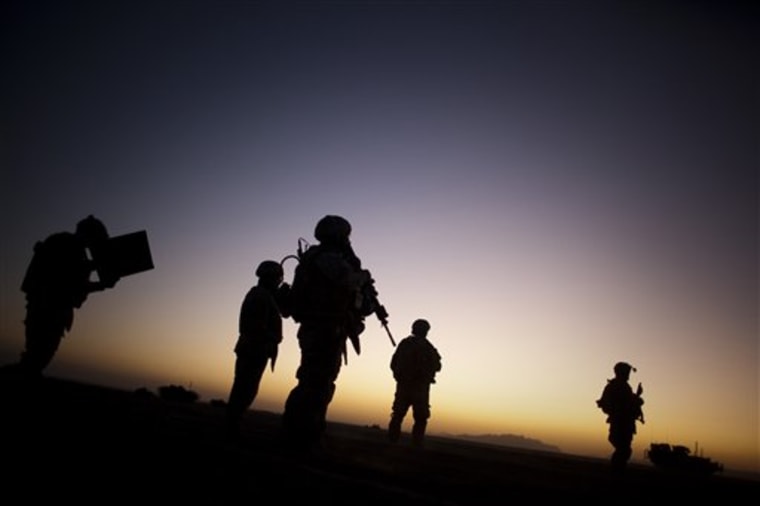More than 100 soldiers in the brigade studied Arabic for 10 months. Their officers boned up on Iraq by reading dozens of books.
Then, five months ago, the 5,000 troops of the U.S. Army's 5th Stryker Brigade were told they were headed to Afghanistan instead.
The Obama administration's decision to switch America's main battlefront from Iraq to Afghanistan is more than a geographic shift. While there are similarities between the two Muslim nations, there are also major differences in language, culture and topography.
The Fort Lewis, Wash.-based Stryker brigade, which arrived in southern Afghanistan last month as part of the U.S. troop surge, is among those scrambling to adapt.
There was only time to give about 50 soldiers a nine-week crash course in Pashto, the main language of southern Afghanistan.
"It was a whole 180-degree turn. It's like English and French: some words are the same but that's it. The grammar is different, the sentences are different," said Spc. John Dazey, a 21-year-old from Vacaville, Calif., who had to fit his training on driving combat vehicles around eight-hour-a-day language classes.
He spoke at the main international base in southern Kandahar province as he waited to deploy out to southeastern Afghanistan.
More conservative, less literate
The soldiers will also encounter a society that is more conservative and traditional than Iraq's.
While two-thirds of Iraq's 28 million people live in major cities, three-fourths of the 34 million Afghans live in rural areas, where conservative values remain strong. Nearly three-quarters of Iraqis can read and write. In Afghanistan, only 28 percent are literate — with rates for women about half that.
All that is especially true among the Pashtuns, the biggest ethnic group and the vast majority of the Taliban. U.S. troops must win over the Pashtuns if there is to be peace in Afghanistan.
Soldiers who've gone through the language course are briefing their comrades on how to interact with the local population — part of the U.S. strategy of building ties to the community.
Dazey has told the men in his squadron to avoid talking to women, or even looking at them — a cursory glance at a burqa-covered woman can be seen by her husband as a lewd come-on.
"The Pashtuns, we've been told the culture is a lot like the Arabic culture except it's on steroids," he said.
Perhaps most importantly, engaging Afghans — and the Pashtuns in particular — requires a different approach.
"Afghanistan is more of a tribal-based society," said Lt. Col. William Clark, commander of the Stryker brigade's 8th Squadron, 1st Cavalry Regiment. "There are more informal leaders you have to recognize."
Enemy is more organized
Conversely, the brigade faces a tightly organized Taliban structure in Kandahar with commanders and even spokespeople, in contrast to the loosely connected insurgency of Iraq.
The Stryker brigade, named after its fast-moving tank-like assault vehicles, is meant to be a next-generation fighting force equipped with advanced communication technology and soldiers skilled in both fighting and peace-building.
Some of the Pashto-speaking soldiers have been given special permission to grow a beard to better interact with men in a culture where a beard is a sign of manhood.
"The fact that so many of the military guys are so against it shows how much cultural importance a beard can have," Col. Harry Tunnell, the brigade commander, said.
Operating in Afghanistan — a country of few roads, no national electricity grid, formidable mountains and bleak stone deserts — presents major challenges.
Soldiers who have done Iraq tours talk about being wowed by Saddam Hussein's palaces. Here they're lucky if they find a road.
At Kandahar Air Field, a massive truck laid down a metal track sturdy enough for the 38,000-pound Strykers to cross.
"When we were going to Iraq, I didn't think we'd be using these bridges at all. Things are more developed there," said 1st Lt. John Davis as he tested a bridge-laying vehicle.
He said they'll use the bridges to establish new routes over small waterways or gullies, or cross areas bombed out by Taliban explosives.
From deserts to mountains
And while terrain in southern Afghanistan is not that different from the Iraqi desert, if the brigade moves farther up the eastern border, they'll confront mountains and valleys still littered with the carcasses of Soviet tanks from the war in the 1980s.
In Iraq these soldiers would have been taking over from existing brigades, but here they're deploying in a part of the country that has only had a sparse international force and never an American presence.
The Stryker vehicles are flown over. The operating bases have to be built and no one knows for sure how the Taliban will respond in an area where they've never been given much of a fight. This will be the first deployment for the brigade and for many of its soldiers, so many are studying up to make sure they're ready for a different theater with a lot more responsibility.
"If we went to Iraq we'd already have assumed operations," said Maj. Joe Hugh, the executive officer of the brigade's Special Troops Battalion, comprised of soldiers with various technical specialties. "Here it's a Rubik's Cube. We're just trying to figure it out every day."
More on: Stryker Brigades
